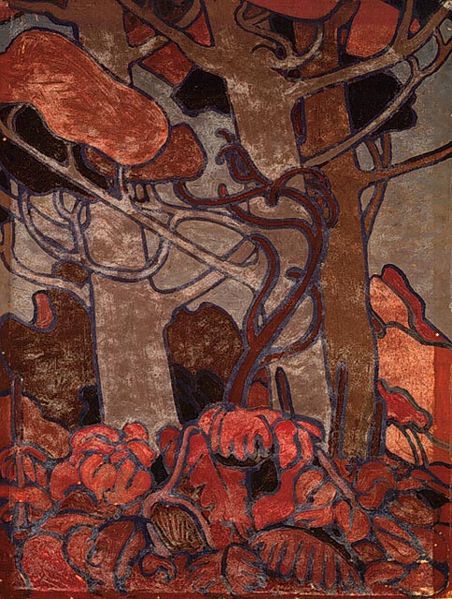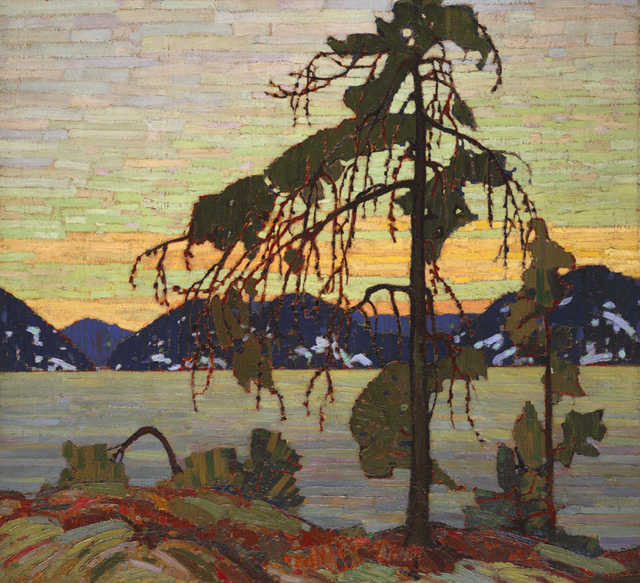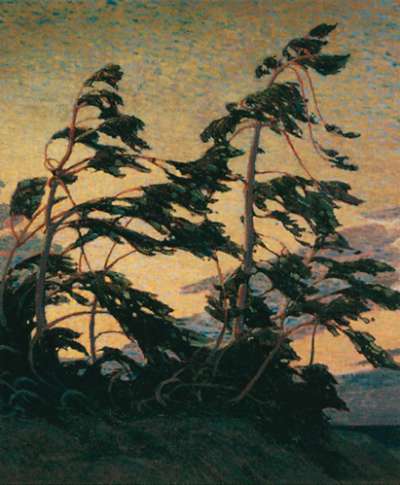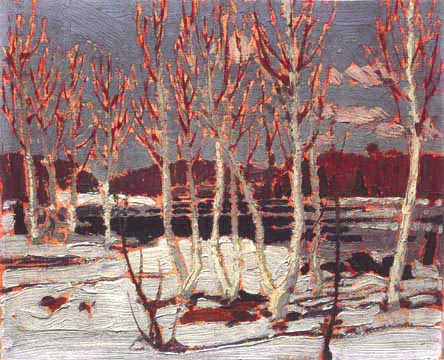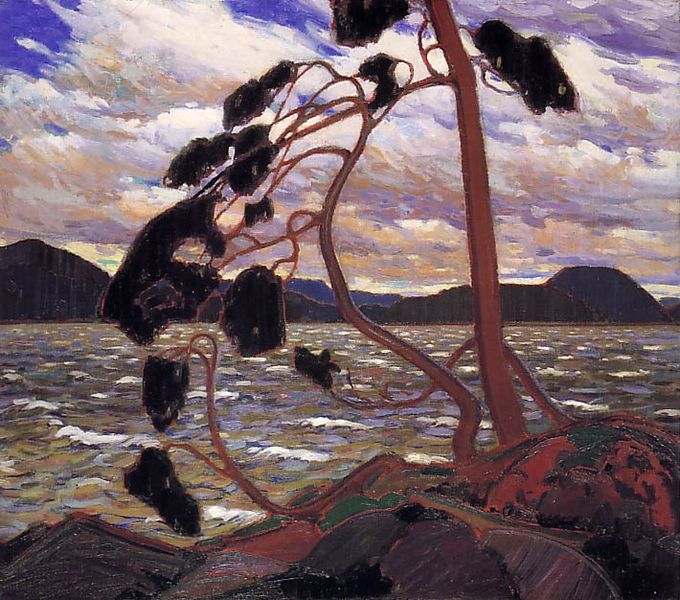<Back to Index>
- Historian Joseph Justus Scaliger, 1540
- Painter Thomas John Thomson, 1877
- Founder of the Socialist People's Party Aksel Larsen, 1897
PAGE SPONSOR
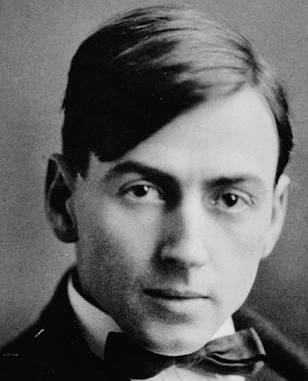
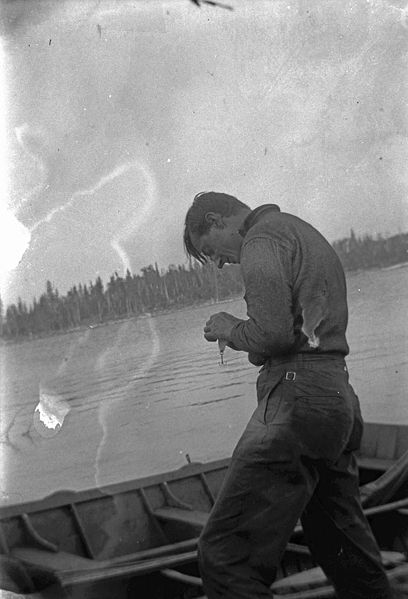
Thomas John Thomson (August 5, 1877 – July 8, 1917), also known as Tom Thomson, was an influential Canadian artist of the early 20th century. He directly influenced a group of Canadian painters that would come to be known as the Group of Seven, and though he died before they formally formed, he is sometimes incorrectly credited as being a member of the group itself. Thomson died under mysterious circumstances, which added to his mystique.
Tom Thomson was born near Claremont, Ontario, to John and Margaret Thomson and grew up in Leith, near Owen Sound. In 1899, he entered a machine shop apprenticeship at an iron foundry owned by William Kennedy, a close friend of his father. He was fired from his apprenticeship by a foreman who complained of Thomson's habitual tardiness. Also in 1899 he volunteered to fight in the Second Boer War, but was refused entry into the armed forces based on a medical condition. Thomson was reputed to have been refused entry into the CEF for service in the First World War as well, but served as a fire ranger in Algonquin Park during this time. In 1901, he enrolled in a business college in Chatham and dropped out eight months later to follow his older brother, George Thomson, who was operating a business school in Seattle, Washington. There he met and had a brief summer romance with Alice Elinor Lambert. In 1904, he returned to Canada, and may have studied with William Cruikshank, 1905 – 1906. In 1907 Thomson joined Grip Ltd., an artistic design firm in Toronto, where many of the future members of the Group of Seven also worked.
Thomson first visited Algonquin Park in Ontario in 1912; thereafter he often travelled with his colleagues around Canada, especially to the wilderness of Ontario, which was to be a major source of inspiration for Thomson. In 1912 Thomson began working, along with other members of the Group of Seven, at Rous and Mann Press, but left the following year to work as an artist full time. He first exhibited with the Ontario Society of Artists in 1913, and became a member in 1914, when the National Gallery of Canada purchased one of his paintings. He would continue to exhibit with the Ontario Society until his death. For several years he shared a studio and living quarters with fellow artists, before taking up residence on Canoe Lake. Beginning in 1914 he worked intermittently as a fire fighter, ranger, and guide in Algonquin Park, but found that such work did not allow enough time for painting. During the next three years he produced many of his most famous works, including The Jack Pine, The West Wind and The Northern River.
Thomson disappeared during a canoeing trip on Canoe Lake in Algonquin Park on July 8, 1917 and his body was discovered in the lake eight days later. The official cause of death was accidental drowning, but there are still questions about how he actually died. It was reported that there was fishing line wrapped around his leg and he had a head injury (which may have been post mortem). It has also been speculated that he was murdered by a German - American neighbour, Martin Blecher, Jr., or that he fell on a fire grate during a drunken brawl with J. Shannon Fraser, owner of Canoe Lake's Mowat Lodge, over an old loan to Fraser for the purchase of canoes. Thomson allegedly needed the money for a new suit to marry Winnifred Trainor, whose parents had a cottage at Canoe Lake. Rumours circulated following his drowning that she was pregnant with Thomson's child. Winnifred Trainor made a trip to Philadelphia with her mother the following winter and returned around Easter. She never spoke about her relationship with Thomson. A nephew, Terrance Trainor McCormick, an upper New York resident who inherited her estate, which included at least 13 small Thomson paintings and letters, said the letters confirm their engagement. McCormick has refused to produce the letters for scholarly investigation. Others believe that Thomson, who produced at least 63 landscape paintings that last spring, many of which he gave away or discarded, suffered severe depression and drowned himself. He was buried at Canoe Lake in Algonquin Park on July 17, 1917, without family members having seen the body. Under the direction of his older brother, George Thomson, the body was exhumed two days later and re-interred in the family plot beside the Leith Presbyterian Church on July 21. None of these theories are conclusive, and the wide range of speculation serves mostly to perpetuate Thomson's romantic legend.
Thomson was largely self-taught. He was employed as a graphic designer with Toronto's Grip Ltd., an experience which honed his draughtsmanship. Although he began painting and drawing at an early age, it was only in 1912, when Thomson was well into his thirties, that he began to paint seriously. His first trips to Algonquin Park inspired him to follow the lead of fellow artists in producing oil sketches of natural scenes on small, rectangular panels for easy portability while travelling. Between 1912 and his death in 1917, Thomson produced hundreds of these small sketches, many of which are now considered works in their own right, and are housed in such galleries as the Art Gallery of Ontario in Toronto and the National Gallery of Canada in Ottawa.
Many of Thomson's major paintings, including Northern River, The Jack Pine, and The West Wind, began as sketches before being expanded into large oil paintings at Thomson's "studio" — an old utility shack with a wood burning stove on the grounds of the Studio Building, an artist's enclave in Rosedale, Toronto. Although Thomson sold few of these paintings during his lifetime, they formed the basis of posthumous exhibitions, including one at Wembley in London, that eventually brought international attention to his work.
Thomson's peaked creatively between 1914 and 1917. He was aided by the patronage of Toronto physician James MacCallum, who enabled Thomson's transition from graphic designer to professional painter.
Although the Group of Seven was not officially founded until after Thomson's death, his work is sympathetic to that of group members A. Y. Jackson, Frederick Varley, and Arthur Lismer. These artists shared an appreciation for rugged, unkempt natural scenery, and all used broad brush strokes and a liberal application of paint to capture the stark beauty and vibrant colour of the Ontario landscape.
Thomson's art bears some stylistic resemblance to the work of such post - impressionists as Vincent Van Gogh and Paul Cézanne, whose work he may have known from books or visits to art galleries. Other key influences were the Art Nouveau and Arts and Crafts movements of the late nineteenth and early twentieth centuries, styles with which he would have been familiar from his work in the graphic arts.
For artist and Thomson biographer Harold Town, the brevity of Thomson's career hinted at an artistic evolution never fully realized. He cites the oil painting Unfinished Sketch as "the first completely abstract work in Canadian art," a painting that, whether or not it was intended as a purely non-objective work, presages the innovations of Abstract expressionism.
Since his death, Thomson's work has grown in value and popularity. In 2002, the National Gallery of Canada staged a major exhibition of his work, giving Thomson the same level of prominence afforded Picasso, Renoir, and the Group of Seven in previous years. In recent decades, the increased value of Thomson's work has led to the discovery of numerous forgeries of his work on the market.
In September 1917 the artists James E.H. MacDonald and John W. Beatty, assisted by area residents, erected a memorial cairn at Hayhurst Point on Canoe Lake, where Thomson died. The cost was paid by MacCallum. It can be accessed by boat. In the summer of 2004 another historical marker honouring Thomson was moved from its previous location nearer the centre of Leith to the graveyard in which Thomson is now buried. In 1967 the Tom Thomson Memorial Art Gallery opened in Owen Sound. Numerous examples of his work are also on display at the National Gallery of Canada in Ottawa, the Art Gallery of Ontario, and the McMichael Canadian Art Collection in Kleinburg, Ontario. Thomson's influence can be seen in the work of later Canadian artists, including Emily Carr, Goodridge Roberts, Harold Town, and Joyce Wieland.
In 1970, Judge William Little published a book, The Tom Thomson Mystery, about his digging up of Thomson's original gravesite in the Mowat Cemetery on Canoe Lake in 1956. He and three companions found a body in what they believed was Thomson's coffin. Medical investigators determined that the body was that of an unknown Native Canadian. However Roy MacGregor has described a new (2009) examination of the 1956 evidence and concluded that the body was actually Thomson, indicating "that Thomson never left Canoe Lake."
Joyce Wieland based a movie (The Far Shore) on the life and death of Tom Thomson.
